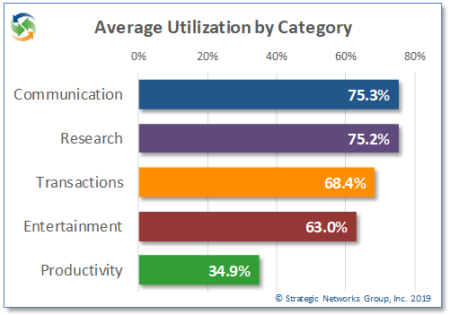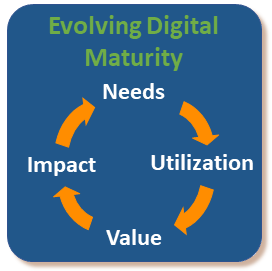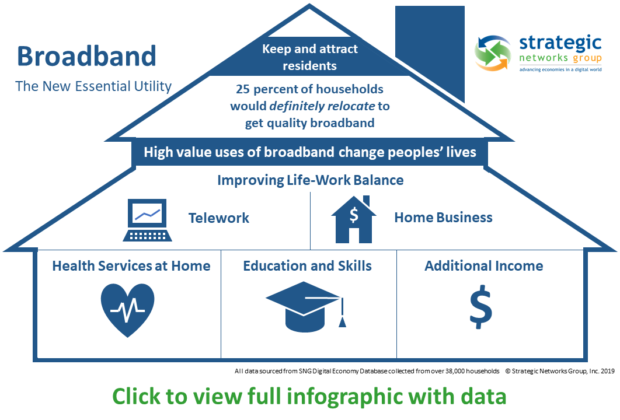Broadband Utilization
The value of broadband comes from how it is used.
SNG has researched for more than a decade how broadband is used by businesses, households, and organizations. How end users leverage technology is what we at SNG call ‘utilization’. We have studied how broadband impacts people’s lives and businesses in communities and regions, as well as the costs of missing out by not having access, or not having the capability to use the online tools needed to effectively participate in an increasingly digital world.
Why does utilization matter?
- Utilization is a direct outcome of people’s awareness and capability to use online applications.
- Showing people why they want or need to use online applications is the key driver of broadband.
- The way people use broadband directly impacts their appreciation of its value, which further drives adoption of new technologies and services.
- How broadband is used delivers positive impacts, not only for the household or business user, but for the community overall.
- For those investing in, or operating broadband networks, take rates and revenues are driven by the user perception of value from how they will use the services.
For households SNG tracks 31 types of utilization broken down into five major categories:
 Communication, such as email, voice, web presence, online chats, etc.
Communication, such as email, voice, web presence, online chats, etc.- Research of information, such as health, community, travel, job search, educational material, government information, etc.
- Transactions online, from buying or selling items online to paying bills, online banking, and government services.
- Entertainment, including consuming news, movies, music, and videos online as well as gaming.
- Productivity uses such as teleworking, education and skills training, and home businesses.
For businesses and organizations (such as government, health, education), SNG tracks 17 types of utilization that reflect typical business practices that can be done or augmented online. These online business practices broadly break down into two categories of use:
- eCommerce are those online business practices that tend to be externally facing, such as selling online, customer service, marketing, web presence, service delivery, and social media.
- eProcess are those online business practices that are more internally facing, such as purchasing, supply chain management, collaboration, employee training, and teleworking.
SNG has accumulated a growing Digital Economy Database of utilization and related information from more than 75,000 households and businesses. SNG’s research shows that different people will use broadband to different degrees. Some will use broadband to its fullest capacity while others will use it minimally for only the basics.
When better broadband is made available in a locality people will sign up. However SNG’s research shows that 53% of businesses and 56% of households underutilize the internet connection they have.
While the innovators and early adopters will subscribe to higher service packages and have high utilization, they represent only 18-25% of the market – not enough for a sustainable business case. The majority of commercial and residential subscribers are underutilizing because they lack capability and have low awareness of what is possible – in other words “they don’t know what they don’t know”. This is true for both businesses and households. This represents a significant opportunity cost to the local economy and community’s quality of life through unrealized revenues, foregone jobs and tax base, etc.
Investing in Utilization
 Meaningful utilization drives value and positive business and community impacts. Increasing utilization by improving digital maturity will increase those impacts for all – for household and businesses, for network providers, and for the community overall.
Meaningful utilization drives value and positive business and community impacts. Increasing utilization by improving digital maturity will increase those impacts for all – for household and businesses, for network providers, and for the community overall.
Raising broadband awareness and digital maturity by investing in marketing, community engagement, and impact tracking, nurtures the market and drives local economic growth and community benefits. Similar to investing in education – there is a foundation that everyone should have (K-12 school) and then students choose next steps based on what type of careers they want. We don’t ask a child what kind of education they want – we ask them what they want to be when they are older. Similarly, for the majority of households and businesses, why are they being asked what kind of subscription they want when they don’t know what they could be doing online, what kind of online presence they want to have – or should have?
Localities and providers need to cultivate the broadband market and nurture demand:
- Engage residents and businesses in what they can aspire to
- Provide training and resources so they can achieve their goals
- Support a lifelong learning process for the community for its vitality
Utilization is driven by needs. People are motivated to subscribe to a broadband service based on how they will use it.
These needs vary and need to be personalized. For example, household needs can be:
 Households with children who need the internet for school study and homework.
Households with children who need the internet for school study and homework.- Seniors who need telehealth service, such as home health monitoring.
- Being able to telework effectively for those who have an opportunity to work remotely.
- Operating a home business with effective access to the internet.
- Earning additional household income online.
- Staying connected with family in other locations.
Similarly, business needs can vary even though many businesses share common needs. Most businesses now recognize that they need a web presence, whether it is a website or through social media, or both. Many businesses sell their product or services online, but how they do this and to what extent depends on those products and their market. Practices such as teleworking may be appropriate for some businesses but not for others.
All of these needs as seen by some are opportunities for others to see a similar value from their own perspectives. Creating awareness and improving digital maturity is essentially an educational process that leads to greater utilization, value, and impacts.
